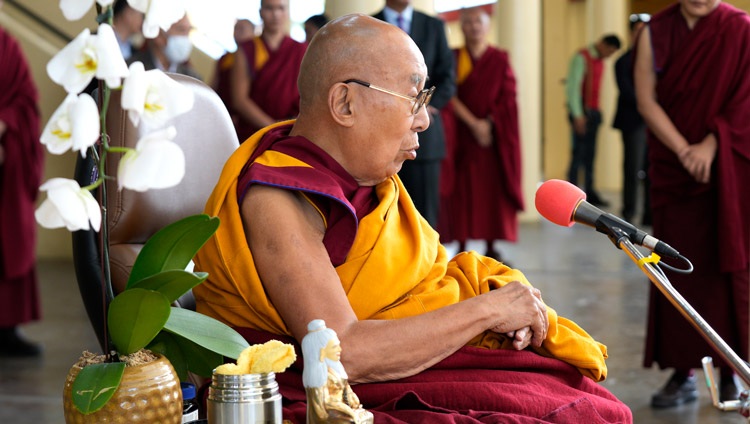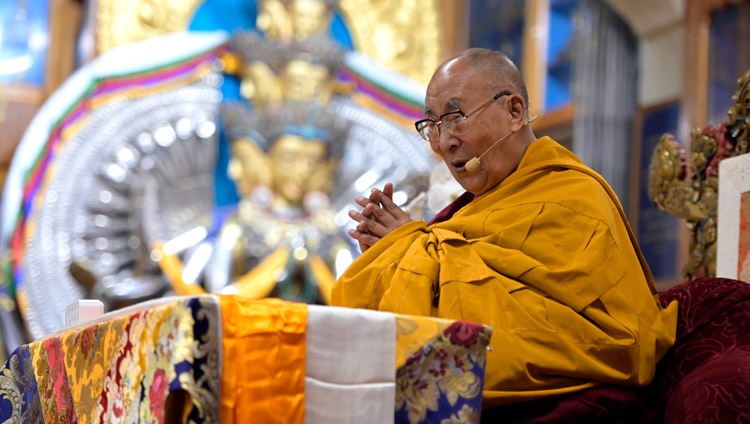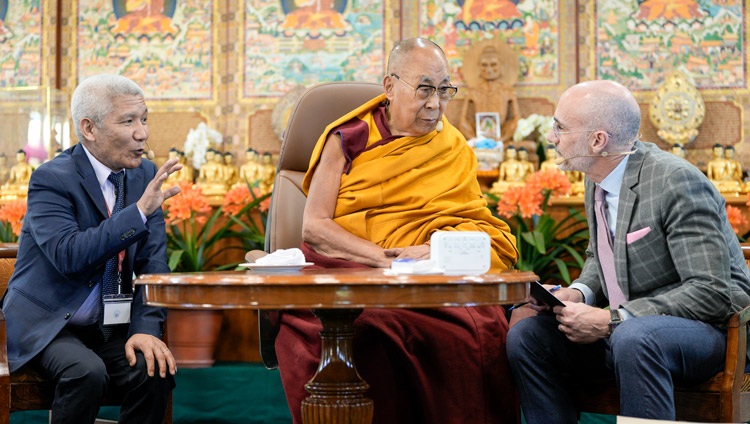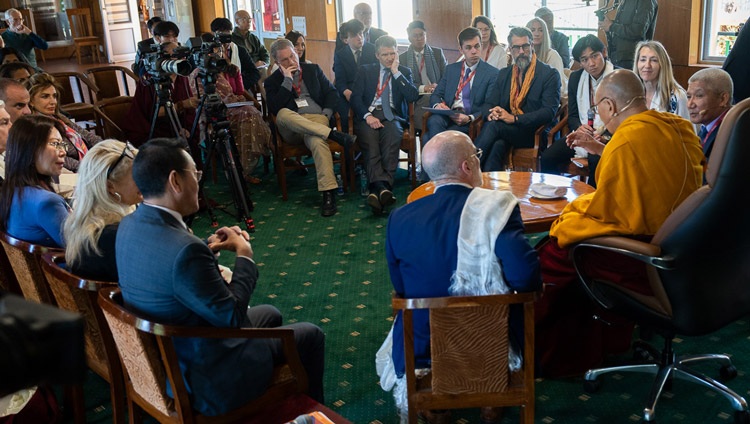Teachings for Mongolians — Second Day
Thekchen Chöling, Dharamsala, HP, India – Today, the clouds had lifted, and sunlight played on the courtyard as His Holiness the Dalai Lama walked to the temple. People sat on either side of the walkway to greet him, with white silk scarves in their folded hands.
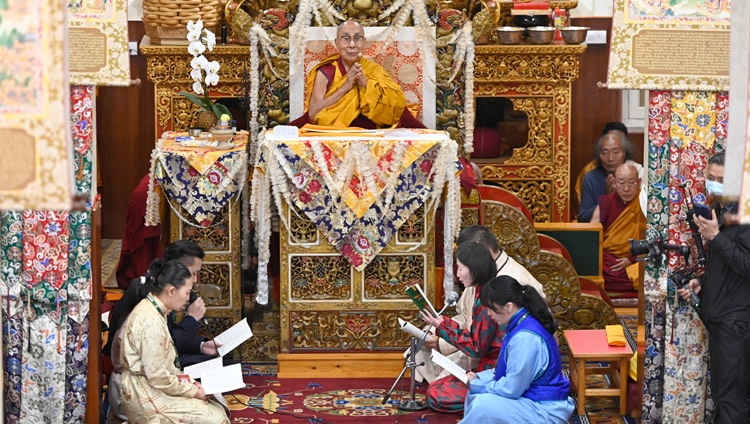
Laypeople reciting the ‘Heart Sutra’ in Mongolian at the start of the second day of His Holiness the Dalai Lama’s teaching at the Main Tibetan Temple in Dharamsala, HP, India on April 20, 2024. Photo by Ven Zamling Norbu
Six Mongolian laypeople sat before His Holiness’s throne and recited the ‘Heart Sutra’ in Mongolian while many of their compatriots sitting in the body of the temple joined in.
His Holiness addressed the congregation: “Today, we have here Tibetan and Mongolian Buddhists, as well as people from elsewhere who are interested in learning about Buddhist teachings. They are attracted by their discovery that Buddhism is based on reason and has a bearing on peace of mind as well as peace in the world.
“As for me, I have reflected on cultivating the awakening mind of bodhichitta and an understanding of emptiness since I was a child. I’ve found them helpful and I’m happy to share what I’ve learned with other people.
“We Tibetans here are living in exile because we lost our country. But where we are doesn’t matter that much because we rely on the Nalanda Tradition that the great Indian master Shantarakshita established in Tibet at the invitation of King Trisong Detsen. This tradition has spread all over Tibet and the Himalayan region. Conditions may change but we have a custom of responding to each other warm-heartedly. This is something worth preserving.
“Tibetans in Tibet continue to wish to follow the tradition introduced by Shantarakshita, and they place their trust in me. Not only in Tibet, but also in mainland China, growing numbers of people are taking an interest in Tibetan Buddhism and its essence—warmheartedness. Tibetan Buddhism includes a thorough understanding of the workings of the mind and emotions, which interests scientists. Other people are keen to know more about training the mind and tackling their emotions.
“Because I meditate on the awakening mind and emptiness every day I have peace of mind and sleep soundly at night. True peace is to be found in our inner world.”

His Holiness the Dalai Lama addressing the congregation on the second day of teachings requested by a group from Mongolia at the Main Tibetan Temple in Dharamsala, HP, India on April 20, 2024. Photo by Ven Zamling Norbu
His Holiness noted that the main disciples for the teaching were Mongolian. He recalled that there has long been a special affinity between Tibetans and Mongolians. Many Mongolians became scholars in Tibet. In his own case, he said, his principal teacher of philosophy and dialectics was a Mongolian called Ngodrup Tsognyi. He remains very grateful for this teacher’s kindness and is happy to repay it to some extent by teaching others, particularly Mongolians.
He observed that spirituality is not just a matter of words. It entails practice and developing good qualities within. It’s not enough for Buddhist monks and nuns to wear the robes; they need to study what the Buddha taught and integrate it within themselves.
“My Dharma friends,” His Holiness observed, “it’s good to remember that we are able to study and practice now due to the traditions passed down by past masters. The Chinese Communists have tried to destroy Buddhism, but many other people in China are showing an interest in Buddhism. We Tibetans need to think carefully about the significance of sharing what we know of the Buddha’s teachings with interested Chinese.”
His Holiness announced that he would like to discuss the awakening mind of bodhichitta. He declared: “Bodhichitta is very precious. It brings peace of mind. It is a powerful way of serving others. There is the Seven-fold Cause and Effect method and the more powerful Equalizing and Exchanging Self and Others approach.
“Taking account of all sentient beings and cultivating the mind that cherishes others more than oneself is powerfully transformative. It brings confidence and peace.”
He advised the congregation to meditate briefly on this. Next, he pointed out that we all have a mind characterized as clarity and awareness and that it is powerful to use it to help others.

Some of the more than 6000 people attending the second day of His Holiness the Dalai Lama’s teaching sitting in the courtyard of the Main Tibetan Temple in Dharamsala, HP, India on April 20, 2024. Photo by Ven Zamling Norbu
“As human beings,” he remarked, “we were nurtured by our mother from the very start of our lives. She planted a seed of kindness within us. Think of all sentient beings, especially the human beings of this world, and imagine extending that sense of kindness to all of them. We can build temples and institutions with a view to preserving the teaching, but what is ultimately most important is to cultivate the the thought of cherishing others more than ourselves. This is how we’ll achieve a life at ease.
“Like us, all human beings wish to be happy. We are the same. That’s why we need to be warm-hearted to everyone. Cherishing others is the source of all good qualities. Cherishing only ourselves is a source of misery. We survive due to the kindness of others, therefore, showing kindness and good heartedness are the simple key to happiness.”
His Holiness counselled his listeners to reflect on the shortcomings of self-cherishing and the advantages of cherishing others. Think, he said, how good it would be if all human beings were happy. Wishing others to be happy brings peace of mind. Think of other beings as friends. The best offering you could give to me, he suggested, would be to cultivate the wish to benefit others.
“My Mongolian Dharma friends,” His Holiness told them, “practice is not just about the prayers you say, it’s about transforming your mind and cultivating a good heart. Reciting mantras is not as effective as cultivating a good heart. When I was a child I came across a parakeet that could recite Om mani padme hung, but with no sense of what it meant. We don’t want to be like that bird. The real way to benefit others is to generate the awakening mind. What you can do is to visualize Avalokiteshvara on the crown of your head and as you recite your ‘manis’ seek his blessings that you may develop a good heart.
“We Tibetans have a custom of reciting ‘manis’ whenever we can, but if, while we’re doing so, our minds wander after jealous thoughts, then it’s not helpful at all.”
His Holiness gave the transmission of the mantras of the three Long Life Deities:
Amitayus — Om amarani jivantaye svaha
White Tara — Om tare tuttare ture mama ayuh punye jnana pushtim kuru svaha
Ushnishavijaya — Om drum svaha om amrita ayu dadai svaha
Representations of the body, speech and mind of enlightenment in the form of a statue of Jé Tsongkhapa, a silver chörten and a precious scripture were presented to His Holiness by the Lamaiin Gegeen.
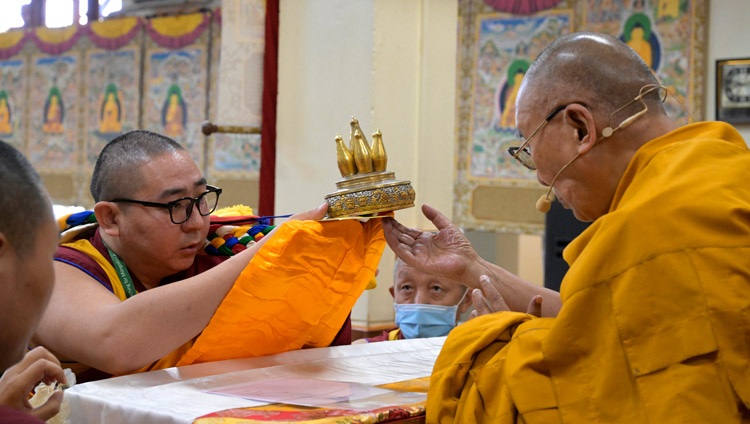
Lamaiin Gegeen offering representations of body, speech and mind on the second day of His Holiness the Dalai Lama’s teaching requested by a group from Mongolia at the Main Tibetan Temple in Dharamsala, HP, India on April 20, 2024. Photo by Ven Zamling Norbu
As a thanksgiving mandala was offered, he made an appeal to His Holiness as follows:
The nature of the kindness showered on the faithful people of Mongolia in general, and upon the successive members of the Lamaiin Gegeen lineage, by your previous incarnations, and particularly by Your Holiness yourself, who are the Buddha for us, and brought to us by the strength of our prayers, is such that even if the entire universe were filled with the seven kinds of precious objects and offered, it would be difficult to repay. Since the welfare of sentient beings and the Buddha Dharma depend on Your Holiness, the Great Treasury of Compassion; and since for us your disciples, otherwise bereft, you are our impeccable refuge, like the eyes in our brows and the hearts in our chests; and since we will have no higher refuge than you in all our future lives, we make this fervent request to you:
Again, in the future, through your unceasing and successive emanations, may you never release us from the hook of your compassion. This is the sole supplication that has lingered long in our minds.
Your great compassionate activities are unending like the rolling of the ocean’s waves, and although it is difficult to make this request, we offer this fervently unflinching supplication:
Just as when a piece of stone is treated as gold, you have showered your compassion on us. In your future incarnations may you continue to be our sole refuge, our supreme field for accumulating merit. May we never be separated from you, who manifests as a monk, wearing the robes and upholding the three vows-Pratimoksha, Bodhisattva and Tantric. From the sphere of your primordial wisdom, may you, the Omniscient One, kindly ensure that we are not separated from the supreme Avalokiteshvara, but are kindly led by him.
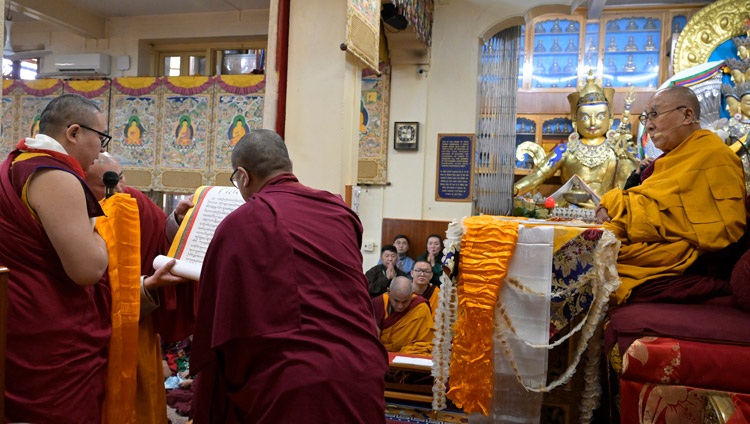
Lamaiin Gegeen reading an appeal to His Holiness the Dalai Lama as the second day of teachings at the Main Tibetan Temple in Dharamsala, HP, India on April 20, 2024. Photo by Ven Zamling Norbu
From our side, as your disciples, under your unexcelled guidance, with the support of the Gaden Phodrang, we remain committed to observing our pure and unwavering commitment. We will please you by obediently carrying out your instructions. We have been sincere until now and there will be no change in the future. We will persevere by every possible means to obediently please you.
May you live long, unwavering, like an indestructible diamond.
His Holiness smiled in acquiescence and as the congregation recited the Mig-tse-ma prayer he left the temple saluting well-wishers as he went and returned to his residence.

